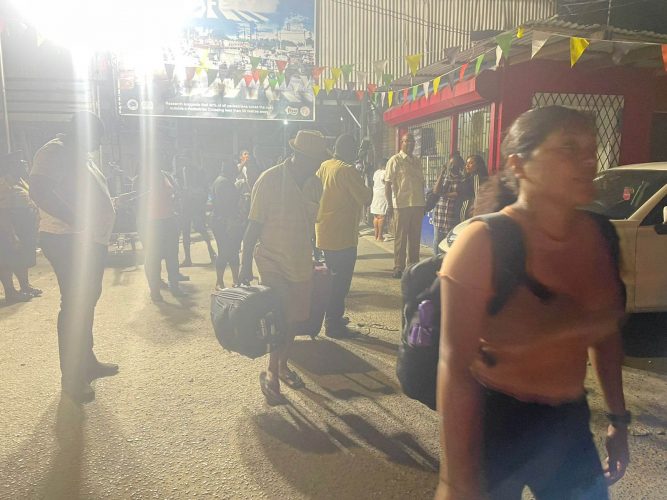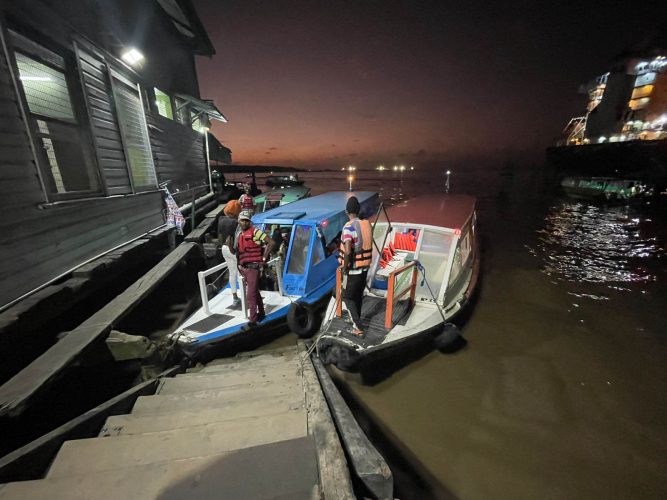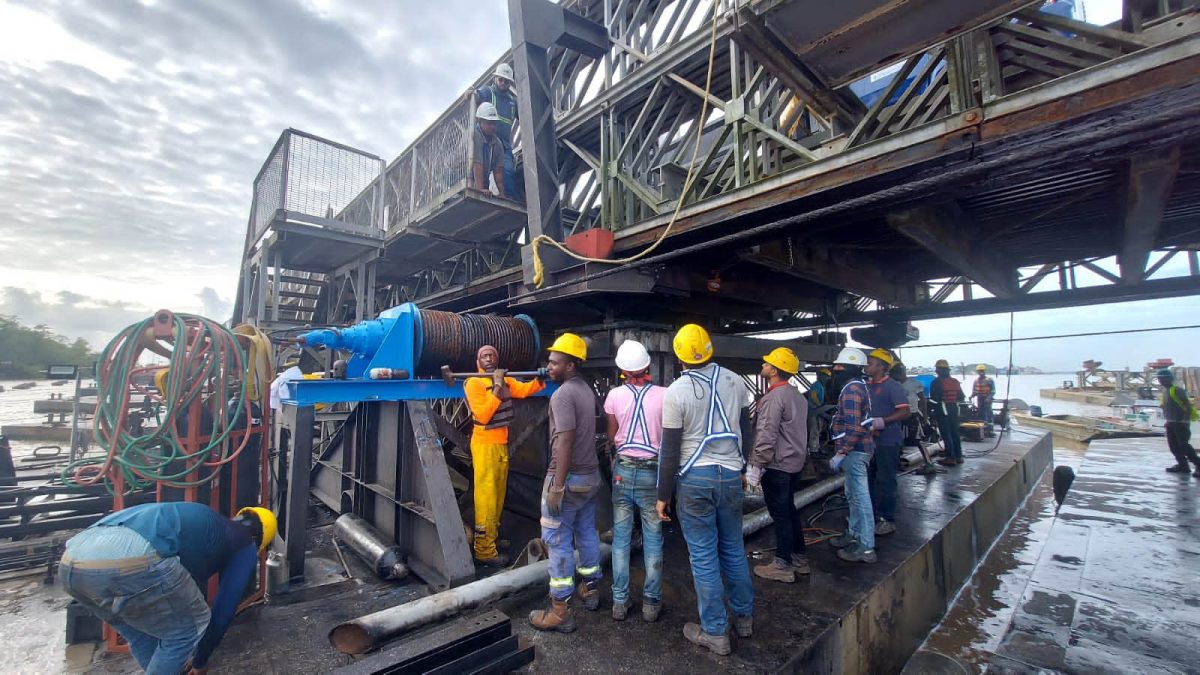Another lengthy closure of the Demerara Harbour Bridge is scheduled for March, Minister of Public Works Juan Edghill last night announced as he inspected the current emergency work being carried out there.
“We have to signal from now. In March… We still have to replace the entire span nine and that is a more tedious, difficult and time-consuming job than dealing with acceptor span eight,” he said.
As of 8 o’clock last night, 60% of the repairs on the Demerara Harbour Bridge were completed and Chairman of the bridge’s Board of Directors Ravie Ramcharitar said it was on schedule to reopen by 3 am today.

“I think they have gotten some of the main components into position and they are now connecting that… So we are generally on schedule,” he explained.
Simultaneously, Ramcharitar said, they were carrying out other maintenance work on the western section of the bridge. Works were being done on the carriageway and support post and deck plates.
The emergency repairs commenced just around 10 pm on Saturday, five hours ahead of the scheduled 24-hour closure. The repairs became critical after the Panama-registered oil tanker, MV Tradewind Passion crashed into the bridge in October last year, and rendered it inoperable for several days.
Over $1 billion have been expended on the emergency repairs, the bridge’s General Manager Wayne Watson said.

According to Watson, the major work on the bridge yesterday entailed changing two static rollers, a transom beam, six panels and the mechanism to secure the changes. Once the repairs began, however, they were faced with some unforeseen challenges which lead to a delay. Nevertheless, the work pressed on with input and manpower from InFab, the contracted company.
“What we encountered this morning [Sunday] whilst trying to remove the static ruler on the left side [was] the timeout panel. When it was hit by the vessel in October, it was tilted about 15 to 30 degrees… So when we tried to raise the structure to take out the static roller, we were focused above but also we realized that the security bolts, that secure the panel to the chair on the pontoon, those ports [were] severed. So, when we focused on raising the bridge upward, the bridge was literally rising from below,” Watson further explained.
This forced the team to return to the table and reengineer the work plan, incurring a three and a half hours deficit.
He saidd manpower was also redirected from less pressing jobs to the emergency work team.
Watson explained that the work could not have been put off as the tide conditions were favourable to execute it.
“We had to get the ‘jack tide’ when the waters were calm and allowed for easy working conditions. Other tides would have affected the work because of the movement of pontoon. And if you do that type of activity when the tide is either going north washing or falling or the rate at which we’re experiencing due to the recent dredging of the river, it would have caused difficulty. We have to work with a specific tide,” he stated. The proposed work in March is also dependent on a similar tide situation.
Meanwhile, Ramcharitar disclosed that they are considering banning speeding trucks. He noted that while there is a weight restriction, speeding trucks contribute significantly to the deterioration of the aged bridge.
“We have taken or we have decided to recommend very strict and harsh measures for such activities. So you will be see heavy vehicles that are speeding, persistently speeding, will be banned from the bridge,” he disclosed.
He said disallowing speeding trucks from traversing the bridge will make a significant difference, as when they hit brakes during speeding that damages the structure. Currently, trucks weighing up to 18,000 tonnes are allowed on the bridge.
“Tonight, I am appealing to all the truckers, I know you want to maximize your trips in delivering your sand or your stone, but take your time…,” Edghill injected.
The Public Works Minister also visited the Vreed- en-Hoop and Stabroek, Georgetown stellings to observe the speedboat operations. While he was there, around 6.30 pm, operations were running fairly smoothly.
It was reported by Transport and Harbour Department authorities that two boats from Vreed-en-Hoop stelling were grounded after the captains increased their fares despite warnings. Once reported, they were pulled from the service and not allowed to work the rest of the day.
Thousands of commuters had no choice but to utilise the water taxis operating between Georgetown and Vreed-en-Hoop, West Demerara, once the bridge closed. Throughout the day, monitors from the Transport and Harbours Department observed the operations and ensured passengers were not being exploited by fare increases due to the demand.
Stabroek News was told that on Saturday many persons who were transporting goods across the river had to hire speed boats.
Overseas travellers were also forced to utilise the water taxis with their suitcases in order to catch flights at the Cheddi Jagan International Airport, Timehri and the Eugene F Correia International Airport, Ogle.
Edghill yesterday thanked the stakeholders involved, including the coastguard, for maintaining a smooth flow of operations. He also expressed gratitude to the police for keeping a presence on the wharves and preventing any criminal activities. He said that the lessons learned from yesterday’s operation will be used to improve the situation at the next lengthy closure.
A water ambulance from Sheriff Medical was also on standby in case of emergencies.
On October 7, around 2 am, the Tradewind Passion, a Panamanian registered vessel, was navigating the channel to offload fuel at GuyOil’s Providence Terminal, when it crashed into the bridge. The vessel was the fifth one to transit the channel, with the previous four experiencing no issue. The crash, believed to be the most serious collision in years on the 44-year-old structure, crumpled sections of the bridge.
At the time of the incident, the vessel was being piloted through the channel by one of Guyana’s five river pilots. Noting the unusual circumstances that led to the accident, the pilot was taken into custody by the Maritime Administration Department (MARAD) and handed over to the police for drug and alcohol testing. However, the results of those tests returned negative and according to MARAD, the vessel was fully manned at the time of the crash.






